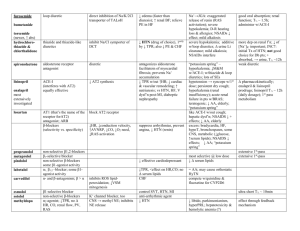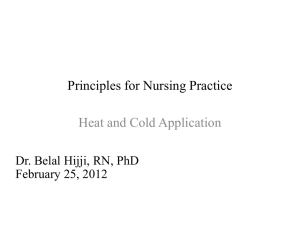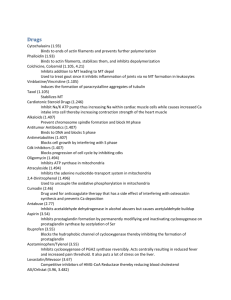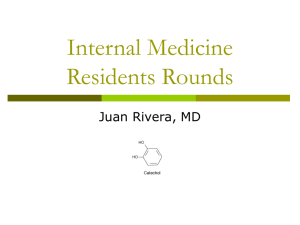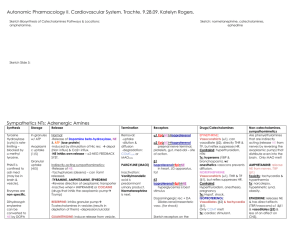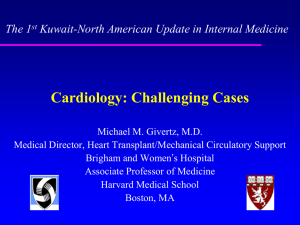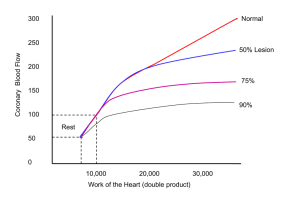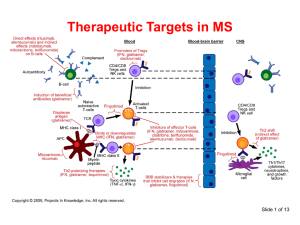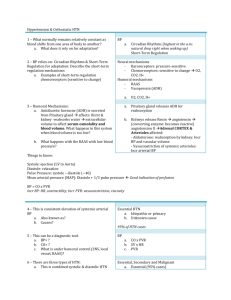Vasodilating Versus First-Generation β
advertisement
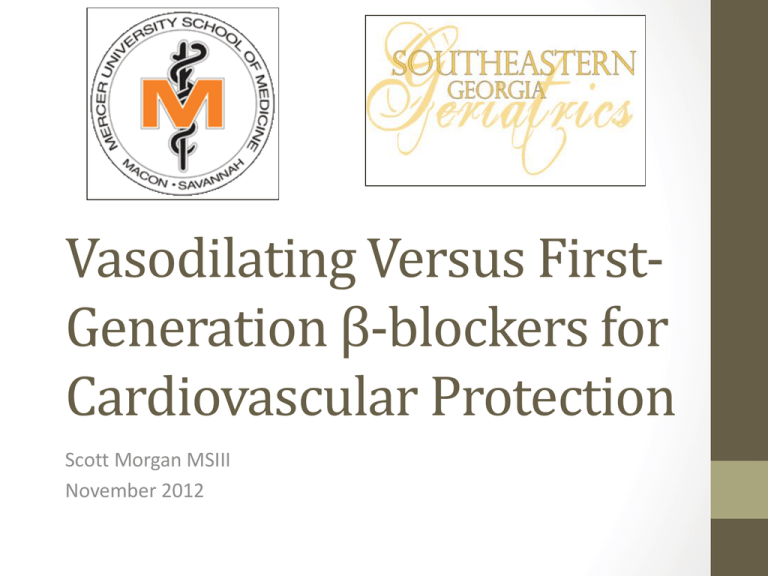
Vasodilating Versus FirstGeneration β-blockers for Cardiovascular Protection Scott Morgan MSIII November 2012 Introduction • Hypertension (HTN) • Defined as BP >140/90 mmHg • Prevalence in US adults is 29% or approximately 59 million • Risk factor for several diseases: • Cardiovascular (CV) • Cerebrovascular • Renovascular • β-blockers • Discovered in mid 1960s • Were first-line HTN treatment previously • Currently falling out of favor due to side effects β-blocker Classes Generation Properties Examples First Nonselective w/o Vasodilation Propanolol, pindolol, nadolol, tindolol, sotalol Second β1-selective w/o Vasodilation Atenolol, bisoprolol, metoprolol Third Nonselective w/ Vasodilation Carvedilol, bucindolol, labetalol β1-selective w/ Vasodilation Nebivolol Vasodilating Effects • First and Second-Generation (older generation) • No vasodilation • Third-Generation • Nonselective w/ Vasodilation • Block vascular α-receptors • Carvedilol, bucindolol, labetalol • β1-selective w/ Vasodilation • Increase NO • Nebivolol 1st Generation Pharmacology • Inhibits catecholamines acting on β1-receptors in heart • Decreases HR and contractility • Leads to decrease CO (SV x HR) and BP • Decreases cardiac work and oxygen demand • Inhibits β1-receptors on juxtaglomerular apparatus in kidneys • Decreases renin release • Leads to decreased activation of renin angiotensin aldosterone system (RAAS) • Inhibits presynaptic transmission in CNS • Decreases catecholamine release Older Gen Clinical Indications • Coronary heart disease • Heart failure • Reduce mortality by 30% in HF w/o preserved ejection fraction • Post-myocardial infarction • Prevent catecholamine arrhythmogenic effects such as ventricular tachyarrhymias • Chronic stable angina • Reduction in cardiovascular events • PTs with • advanced age • LV dysfunction • Anterior MI Older Gen for Blood Pressure • Deceased CO • Rebound peripheral vasoconstriction to maintain BP • Leads to chronic HTN • Decreased skeletal muscle perfusion • Adverse effects on lipid and glucose metabolism • Less effective in elderly and black populations • Tend to have low plasma renin HTN • Diuretics are more effective • Contraindicated in asthmatics • β2 effects cause bronchoconstriction • Failed to show reduction in myocardium remodeling • LVH still occurs similarly to uncontrolled HTN Compliance Issues • • • • Lethargy Drowsiness Depression Peripheral vascular effects • Cold extremities • Sexual side effects • Erectile dysfunction • Orgasmic dysfunction • Can worsen • Diabetes mellitus • Decreased insulin release by block β2 receptors in pancreas • COPD • PVD rd Nonselective 3 Gen β-blockers • Carvedilol, bucindolol, metoprolol • Block vascular α-receptors • Decreased PVR and increased glucose delivery to muscles • Increases insulin sensitivity • Normally vasodilates by NO, but vasoconstricts by SNS • Diabetes and HTN blunt NO effects allowing SNS to increase PVR • Can raise HDL and lower LDL levels • Increases renal blood flow • Less activation of RAAS • Reduces microalbuminuria • No negative BUN/creatinine effects Carvedilol • Better tolerated in elderly • Body already has β-blocker like effects • Decreased β-adrenergic response and increased catecholamine levels • Less β-blocking effects and more vasodilation • Less sympathetic activation • Fewer adverse effects • More compliance • Most common side effects • HA • Dizziness • Orthostatic hypotension Nebivolol • Highest cardioselectivity of the β blockers • Vasodilates • Inhibits NADPH oxidase • decreased oxygen radical development • Produces lower peroxynitrite levels • Prevents endothelial cell NO synthesis (eNOS) • Increased levels of NO • Inhibits platelet aggregation • NO normally inhibits aggregation • Inhibits atherosclerosis • Inhibits edothelin-1 which normally promotes cell growth • Increased exercise tolerance compared to traditional β-blockers β-blocker Properties Summary • Third generation β-blockers are more effective at controlling HTN than traditional • More favorable metabolic effects • Better choice with multiple comorbid conditions • Safer in elderly and black populations • Fewer side effects • Older generation β-blockers are still useful for treatment of other cardiovascular diseases Citation • Fares, Hassan et al. Vasodilating Versus First-Generation βblockers for Cardiovascular Protection. Postgraduate Medicine. Volume 124; Issue 2: 7-14. March, 2011.
